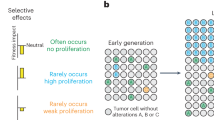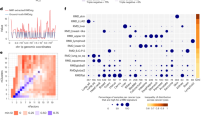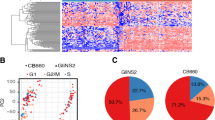Summary
Selected childhood and adult neoplasm exemplify fundamental differences in their propensity for genomic change. DNA replication is essential for the formation of neuroepithelial tumors, probably because the genome can be remodeled. Nonetheless, several differentiated and stable childhood neoplasms retain their nuclear controls for differentiation. In contrast, rapidly arising gliomas often show a variety of phenotypic changes. Genomic plasticity and instability allow gliomas to flexibly adapt to new environments. Gene changes (in DNA) can be limited in childhood tumors whereas more widespread genetic changes in malignant gliomas indicate a fundamental alteration in many chromosome regions. Can such regions be defined? We used one repeated DNA sequence (TTAGGG)n, present at the end of all normal human chromosomes, to investigate chromosome termini in more detail. Pulsed-field gel electrophoresis showed this region can be unusually variable, as several other multilocus probes did not reveal comparable changes. Because telomeres form unique chromosomal structures, and are thought to provide essential signals to position chromosomes in the interphase nucleus, it was pertinent to assess these regions by in situ hybridization. Many telomeric domains localized at variable as well as interior nuclear positions in glioma cells. These positions, which are presumably abnormal, may be generated by the DNA variants observed. Such position changes may contribute to the more general ‘disorder’ observed in glioma nuclei. Other chromosome domains with a unique DNA-protein structure may define additional genomic loci that are preferentially modified in neoplasia. A fundamental understanding of chromosome structure should clarify the problem of multilocus instability in glioblastoma.
Similar content being viewed by others
References
Manuelidis L, Manuelidis EE: An autoradiographic study of the proliferation and differentiation of glial cellsin vitro. Acta Neuropath 18: 193–213, 1971
Manuelidis L: A view of interphase chromosomes. Science 250: 1533–1540, 1990
Reik W, Surani MA: Genomic imprinting and embryonal tumors. Nature 338: 112–113, 1989
Weinberg RA: Tumor suppressor genes. Science 254: 1138–1146, 1991
Manuelidis EE: Heterologous transplantation of cerebral and cerebellar astrocytomas. Acta Neuropath 20: 160–170, 1972
Greene HSN, Arnold H: The homologous and heterologous transplantation of brain and brain tumors. J Neurosurg 2: 315–331, 1945
Friend SH, Bernards R, Rogelj S,et al.: A human DNA segment with properties of the gene that predisposes to retinoblastoma and osteosarcoma. Nature 323: 643–646, 1986
Huang H-JS, Yee J-K, Shew J-Y,et al.: Suppression of the neoplastic phenotype by replacement of the RB gene in human cancer cells. Science 242: 1563–1566, 1988
Chen TL, Manuelidis L: Neuroblastoma double minutes isolated by pulsed field gel electrophoresis without prior strand cleaving treatments. Genomics 4: 430–433, 1989
Solomon E, Borrow J, Goddard AD: Chromosome aberrations and cancer. Science 254: 1153–1160, 1991
Manuelidis L, Manuelidis EE: Surface growth characteristics of defined normal and neoplastic neuroectodermal cellsin vitro. Prog Neuropath 4: 235–266, 1979
Manuelidis L: Active nucleolus organizers are precisely positioned in adult central nervous system cells but not in neuroectodermal tumor cells. J Neuropath Exp Neurol 43: 225–241, 1984
Zehnbauer BA, Small D, Brodeur GM, Seeger R, Vogelstein B: Characterization of N-myc amplification units in human neuroblastoma cells. Mol Cell Biol 8: 522–530, 1988
Trojanowski JQ, Tohyama T, Lee VM: Medulloblastomas and related primative neuroectodermal brain tumors of childhood recapitulate molecular milestones in the naturation of neuroblasts. Mol Chem Neuropath 17: 121–135, 1992
Valtz NL, Hayes TE, Norregaard T, Liu SM, McKay RD: An embryonic origin for neuroblastoma. New Biologist 3: 364–371, 1991
Zu Rhein GM: Studies of JC virus-induced nervous system tumors in the Syrian hamster: a review. In: Sever JL, Madden DL (eds) Polyomaviruses and Human Neurological Diseases. Alan R. Liss, New York, p. 205
Taruscio D, Manuelidis L: Integration site preferences of endogenous retroviruses. Chromosoma 101: 141–156, 1991
Bishop JM: Cellular oncogenes and retroviruses. Ann Rev Biochem 52: 301–354, 1983
Bishop JM: The molecular genetics of cancer Science 235: 305–311, 1987
zur Hausen H: Viruses in human cancers. Science 254: 1167–1173, 1991
Pond AR, Manuelidis EE: Oncolytic effect of poliomyelitis virus on human epidermoid carcinoma (HeLa tumor) heterologously transplanted to guinea pigs. Am J Path 45: 233–249, 1964
Rous P, Kidd JG: Conditional neoplasms and subthreshold neoplastic states. J Exp Med 739: 365–389, 1941
Ludwin SK: Proliferation of mature oligodendrocytes after trauma to the central nervous system. Nature 308: 274, 1984
Manuelidis L, Manuelidis EE: Proliferation and response of oligodendrocytes. Lab Invest 52: 1–2, 1985
Sidransky D, Mikkelsen T, Schwechheimer K, Rosenblum ML,et al.: Clonal expansion of p53 mutant cells is associated with brain tumor progression. Nature 355: 846–847, 1992
Manuelidis EE: Experiments with tissue culture and heterologous transplantation of tumors. Ann NY Acad Sci 159: 409–431, 1969
Ariza A, Fernandez LA, Inagami T, Kim JH, Manuelidis EE: Renin in glioblastoma multiforme and its role in neovascularization. Am J Clin Path 90: 437–441, 1988
Trojan J, Johnson TR, Rudin SD, Ilan J, Tykocinski J, Ilan J: Treatment and prevention of rat glioblastomas by immunogenic C6 cells expressing antisense insulin-like growth factor I RNA. Science 1993
Libermann TA, Nusbaum HR, Razon N, Kris R,et al.: Amplification, enhanced expression and possible rearrangement of EGF receptor gene in primary human brain tumors of glial origin. Nature 313: 144–147, 1985
Wong AJ, Bigner SH, Bigner DD, Kinzler KW,et al.: Proc Natl Acad Sci (USA) 84: 6899–6903, 1987
Yamazaki H, Fukui Y, Ueyama Y, Tamaoki N,et al.: Amplification of the structurally and functionally altered epidermal growth factor receptor gene (c-erbB) in human brain tumors. Mol Cell Biol 8: 1816–1820, 1988
Mittelman F: Catalogue of chromosome aberrations in cancer. Second edition, Liss, New York, 1985
Cremer T, Lichter P, Borden J, Ward DC, Manuelidis L: Detection of chromosome aberrations in metaphase and interphase tumor cells by in situ hybridization using chromosome-specific library probes. Hum Genetics 80: 235–246, 1988
du Manoir S, Speicher MR, Joos S, Schröck E,et al.: Detection of complete and partial chromosome gains and losses by comparative genomic in situ hybridization. Hum Genet 90: 590–610, 1993
Cremer T, Tesin D, Hopman AHN, Manuelidis L: Rapid interphase and metaphase assessment of specific chromosomal changes in neuroectodermal tumor cells by in situ hybridization with chemically modified DNA probes. Exp Cell Res 176: 199–220, 1988
McClintock B: The stability of broken ends of chromosomes in Zea mays. Genetics 26: 234–282, 1941
Blackburn EH: Structure and function of telomeres. Nature 350: 569–573, 1991
Moyzis RK, Buckingham JM, Cram LS, Dani M,et al.: A highly conserved repetitive DNA sequence (TTAGGG)n, present at the telomeres of human chromosomes. Proc Nat Acad Sci USA 85: 6622–6626, 1988
Lundblad V, Szostak JW: A mutant with a defect in telomere elongation leads to senescence in yeast. Cell 57: 633–643, 1989
Harley CB, Futcher AB, Greider CW: Telomeres shorten during aging of human fibroblasts. Nature 345: 458–460, 1990
Counter CM, Avillon AA, LeFeuvre CE, Stewart NG,et al.: Telomere shortening associated with chromosome instability is arrested in immortal cells which express telomerase activity. EMBO J 11: 1921–1929, 1992
Andrews PW, Damjanov I, Simon D, Banting GS,et al.: Pluripotent embryonal carcinoma clones derived from the human teratocarcinoma cell line Tera-2. Lab Invest 50: 147–162, 1984
Manuelidis L, Ward DC: Chromosomal and nuclear distribution of the Hind III 1.9 kb repeat sequence. Chromosoma 91: 28–38, 1984
Chen TL, Manuelidis L: SINEs and LINEs cluster in distinct DNA fragments of Giemsa band size. Chromosoma 98: 309–316, 1989
de Lange T, Shiue L, Myers RM, Cox DR,et al.: Structure and variability of human chromosome ends. Mol Cell Biol 10: 518–527, 1990
Heidmann O, Heidmann T: Retrotransplantation of a mouse IAP sequence tagged with an indicator gene. Cell 64: 159–170, 1991
Manuelidis L: Different CNS cell types display distinct and non-random arrangements of satellite DNA sequences. Proc Natl Acad Sci USA 181: 3123–3127, 1984
Matsera AG, Ward DC: Oligonucleotide probes for the analysis of specific repetitive DNA sequences by fluorescence in situ hybridization. Hum Mol Genet 1: 535–539, 1992
Manuelidis L, Borden J: Reproducible compartmentalization of individual chromosome domains in human CNS cells revealed by in situ hybridization and three-dimensional reconstruction. Chromosoma 96: 397–401, 1988
de Lange T: Human telomeres are attached to the nuclear matrix. EMBO J 11: 717–724, 1992
Manuelidis L: Heterochromatic features of an 11 Mb transgene in brain cells. Proc Natl Acad Sci USA 88: 1049–1053, 1991
Greenfield I, Nickerson J, Penman S, Stanley M: Human papilloma virus 16 E7 protein is associated with the nuclear matrix. Proc Natl Acad Sci USA 88: 1217–1221, 1991
Hoffman M: The cell nucleus shapes up. Science 259: 1257–1259, 1993
Manuelidis L, Chen TL: A unified model of eukaryotic chromosomes. Cytometry 18: 8–25, 1990
Kim Y, Geiger JH, Hahn S, Sigler PB: Crystal structure of a yeast TBP/TATA-box complex. Nature 365: 512–520, 1993
Author information
Authors and Affiliations
Rights and permissions
About this article
Cite this article
Manuelidis, L. Genomic stability and instability in different neuroepithelial tumors. A role for chromosome structure?. J Neuro-Oncol 18, 225–239 (1994). https://doi.org/10.1007/BF01328957
Issue Date:
DOI: https://doi.org/10.1007/BF01328957




